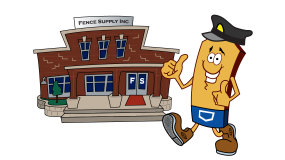If you’re responsible for choosing a chain link fence, you’ve probably discovered that it’s not as easy as going to your fencing supply warehouse and telling them how much fence you need. There are different materials, types, and varieties of chain link to choose from, and one size definitely does not fit all.
Chain links are commonly classed based on the type of coating applied to the wires, the gauge or size of the wire, and the sizes of the square or diamond mesh.
Basic wire materials
There are three basic wire materials to choose from for your chain link fence: zinc-coated wires, aluminum wires, and stainless steel wires.
Zinc-coated, or galvanized, wires are dipped into zinc and galvanized using two different approaches. One is to galvanize after weaving (GAW), and the other is to galvanize before weaving (GBW). There are many different opinions on which type to use since, GAW chain link fence may have uncoated portions where the mesh touches, while GBW chain link fence will have uncoated portions at wire endings. More people would recommend a GAW finish. Despite this, both types are expected to last at least 12 years with no maintenance needed. This makes galvanized chain link fence appropriate for use on residential or private property enclosures.
Aluminum chain link fence has the advantages of being corrosion-resistant, weather-resistant, lightweight, long-lived, and of having a high tensile strength. The coating process is the same with that of the galvanized wire. This type of chain link fence is recommended for commercial or public use such as on school grounds or on a ranch. Due to its durability, aluminum chain link fences are expected to last up to 25 years, even in harsh weather conditions.
Stainless steel wires are the most durable of all chain link wire materials and as a result, they have higher costs. This type has high alkali resistance, can sustain high temperatures, and is also resistant to harsh weather conditions. Additionally, stainless steel wires are not prone to breakage, rolling, or sagging, which enables them to retain their shape over long periods of time. This chain link fence type is recommended for high-grade enclosures or barriers such as those on airports, highways, railroads, and other applications which require high-level performance.
Additional wire coating materials
To provide additional durability and enhanced aesthetics, many decide to coat their chain link fences with paint. Although this is more economical, paint is prone to cracking and peeling which would require cheap but frequent maintenance. Paint will only be of service for around 3 to 5 years.
Plastic coating is another way to add color to your chain link fence using polyvinyl chloride, or PVC. When properly applied, PVC will not easily crack or peel. As a result, your chain link fence will have lasting protection again rust, scratches, and other physical deterioration. The PVC will also provide additional aesthetic quality to your fence since these materials naturally shine and come in various colors.
Wire gauge and wire mesh sizes
Wire gauge and mesh sizes depend on the security risks and the anticipated tension your chain link fence may bear. In choosing your chain link fence, pick those with smaller mesh sizes and wire gauges as security risks and anticipated fence tension increases.



